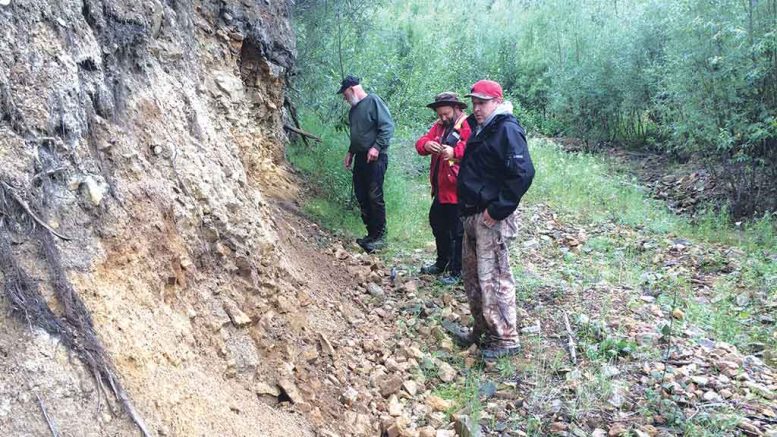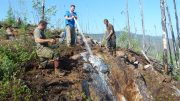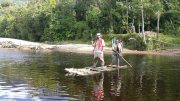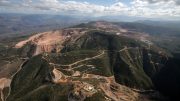VANCOUVER — A new spin on target generation at Triumph Gold’s (TSXV: TIG) Freegold Mountain gold project in south-central Yukon has enticed international miner Goldcorp (TSX: G; NYSE: GG) to take a 19.9% stake in the junior for $6.3 million.
Goldcorp bought 11.9 million flow-through shares of Triumph — formerly Northern Freegold Resources — at 53¢ per share, as part of a charity flow-through arrangement.
The money will be partly used to fund Triumph’s 14,000-metre drill program this year, which will target porphyry-style copper-gold mineralization that previous explorers may have overlooked.

The geology underlying Triumph’s three main target areas at its Freegold Mountain project in the Yukon. Credit: Triumph Gold.
“Goldcorp’s investment is the best case scenario for us. We have enough funding for the next two years to test all of our new ideas, focus on the geology and find Yukon’s next mine … and that’s a great position to be in,” Triumph’s vice-president of exploration Tony Barresi tells The Northern Miner during a phone interview.
Before joining Triumph as an officer in January, Barresi worked as a consultant to Triumph to investigate the large amount of data on the project’s two main porphyry resources: Revenue and Nucleus. Barresi spent over a month at the property last year, relogging drill core, mapping and taking a closer look at outcrops.

Location map of Triumph’s Freegold Mountain project relative to major projects in southcentral Yukon. Credit: Triumph Gold.
“We discovered a whole bunch of interesting things, but we became really excited when we realized that there was an earlier stage of porphyry mineralization that hasn’t been recognized before. Some of the longest and best gold grades in drilling — at both Revenue and Nucleus — are related to that early porphyry event.”
The porphyry was later overprinted by mineralized hydrothermal breccias, quartz-porphyry dikes and a long, vertical pipe called a diatreme, which formed when gas-filled magma exploded its way through the rock.
“In the data sets, the diatreme and breccias are an exploration bull’s-eye, and that’s what previous exploration focused on. I don’t think there was a recognition that the host rocks for the diatreme may have actually been genetically related to the mineralization,” Barresi says.
The 200 sq. km property sits within the Tintina gold belt, which is home to numerous, multimillion-ounce epithermal gold and porphyry copper-gold deposits, including Kinross Gold’s (TSX: K; NYSE: KGC) Fort Knox gold mine in Alaska, Goldcorp’s Kaminak Coffee gold project, Western Copper and Gold’s (TSX: WRN; NYSE-MKT: WRN) Casino copper-gold project and Capstone Mining’s (TSX: CS) producing Minto copper mine, all in the Yukon.
When asked why he left the consulting firm Seven Devils Exploration to join Triumph, Barresi replied that he has “rarely seen a property that’s so ripe for geological interpretation … I wanted to dig my teeth into it and see if I could find something.”
He says Goldcorp requested a private meeting to discuss the geological interpretations after hearing about the results at the Yukon Geoscience Forum last November.
“When we look at the geological data associated with the early porphyry event, we see a whole bunch of open ground on the property that is virtually untested by drilling,” he says.

1.5 metre-thick quartz-pyrite chalcopyrite vein hosted in a biotite-altered, bornite-bearing porphyry, as observed at Triumph Gold’s Generation zone. Credit: Triumph Gold.
Triumph has flagged three targets for follow up: Nucleus, Blue Sky and Generation.
At Nucleus, most mineralization was thought to be controlled by quartz-porphyry dikes along the margin of a microgranite, with 74 million indicated tonnes of 0.54 gram gold per tonne and 63.8 million inferred tonnes of 0.39 gram gold, assuming a 0.3 gram gold cut-off, noted in resources.
But after some data sleuthing, Barresi says that mineralization appears to follow the edges of the microgranite, rather than the dikes.
“The mineralization looks more like space-filling replacement zones, analogous to a skarn,” he says. “Although the dikes introduced and remobilized some metals, the data suggests that the earlier porphyry event was more important in terms of total metal endowment. So we believe there’s another 2.5 km circumference of microgranite contact that could be mineralized, and it has never been drill tested.”
The second target Triumph plans to test is at Revenue, where previous exploration outlined an inferred resource of 80.8 million tonnes of 0.39 gram gold, 3.45 grams silver per tonne, 0.14% copper and 0.05% molybdenum along the southern edge of a diatreme that crosscuts a microgranite.

A map displaying an untested, intense chargeability high underlying Triumph’s Generation zone. Location of discovery outcrop as noted in the picture. Credit: Triumph Gold.
“On the eastern side of the Revenue diatreme there are three holes, among the last ever drilled, and they have some of the best copper-gold-molybdenum intercepts in the area. At surface we see chargeability highs, magnetic anomalies and associated soil anomalies — all the good stuff you want to see for a large porphyry system — but the mineralization wasn’t hosted in the diatreme, so the holes were never followed up with additional drilling,” he says.
Drilling this year will also test the Generation zone, which Barresi stumbled upon during fieldwork last year.
Generation is 800 metres north of the Revenue diatreme.
“The overburden in the area is thick, but placer mining has exposed a couple of outcrops in the streams. One of the outcrops had dense quartz-sulphide stockworks, whereas the other got us particularly excited, because it was biotite altered with traces of bornite … there was also a 1.5-metre-thick, quartz-chalcopyrite vein ripping right down the middle. But what blew us away is that it’s never been drilled, even though it represents the high-temperature core of a porphyry system,” he says.
He adds that the mineralization sits 150 metres above the modelled depth of an intense chargeability high that spans 2 by 1 km.
Historical samples taken from the outcrop returned up to 0.3% copper and up to 0.23 gram gold, which may be why previous explorers ranked the target as low priority, Barresi adds.
“It just didn’t pass the grade test and wasn’t recognized as potentially being part of a much larger porphyry system,” he says. “People are knocking themselves out right now looking for a buried porphyry, and if you drilled into something that looks like this outcrop, you’d go crazy. These outcrops are minuscule in size, the grade could be just next door … think of all the locations within a porphyry system where you’re going to get sub-economic grade — they’re all over the place. You can drill a couple of holes in the world’s best porphyry deposits and not hit ore grade.”
Triumph is the newest addition into Goldcorp’s portfolio of significant stakes in junior explorers.
Since early 2016, it has driven $58.4 million into juniors that have projects with district-scale potential, as a way to increase its exposure to greenfield discoveries.
The miner plans to invest up to $100 million in 15 to 20 juniors, as announced during this year’s Association for Mineral Exploration Roundup convention in Vancouver.
Other juniors in Goldcorp’s portfolio include Gold Standard Ventures (TSXV: GSV; NSYE-MKT: GSV), Sirios Resources (TSXV: SOI), Independence Gold (TSXV: IGO) and Auryn Resources (TSX: AUG; US-OTC: GGTCF).
Triumph shares have traded within a 52-week range of 23¢ to 50¢, and closed at 39¢ at press time. The company has 59.7 million shares outstanding for a $23.9-million market capitalization.






Be the first to comment on "Goldcorp takes 19.9% stake in Triumph"